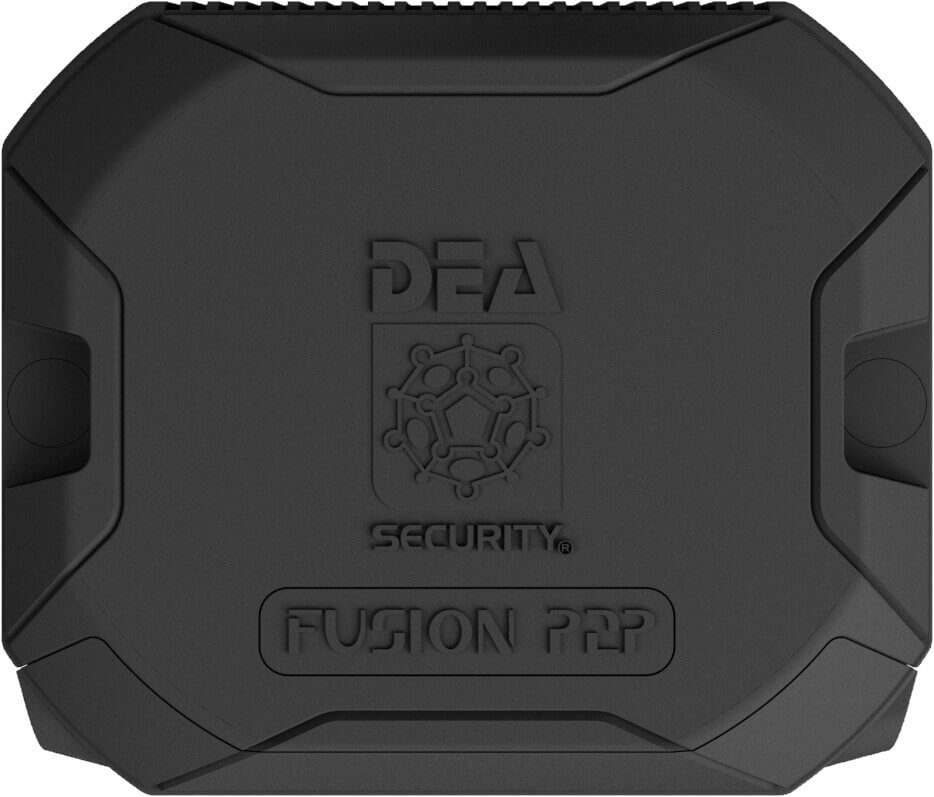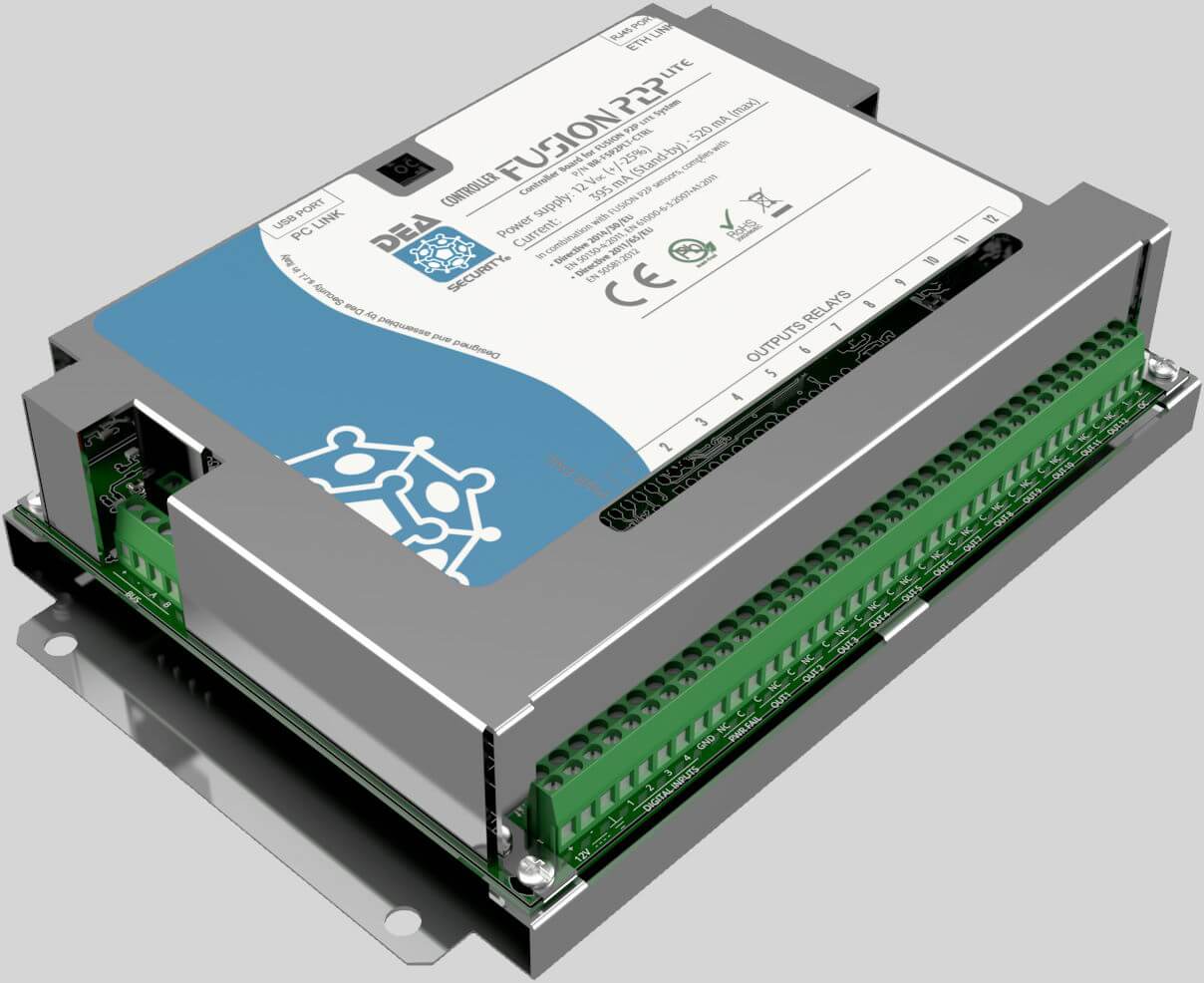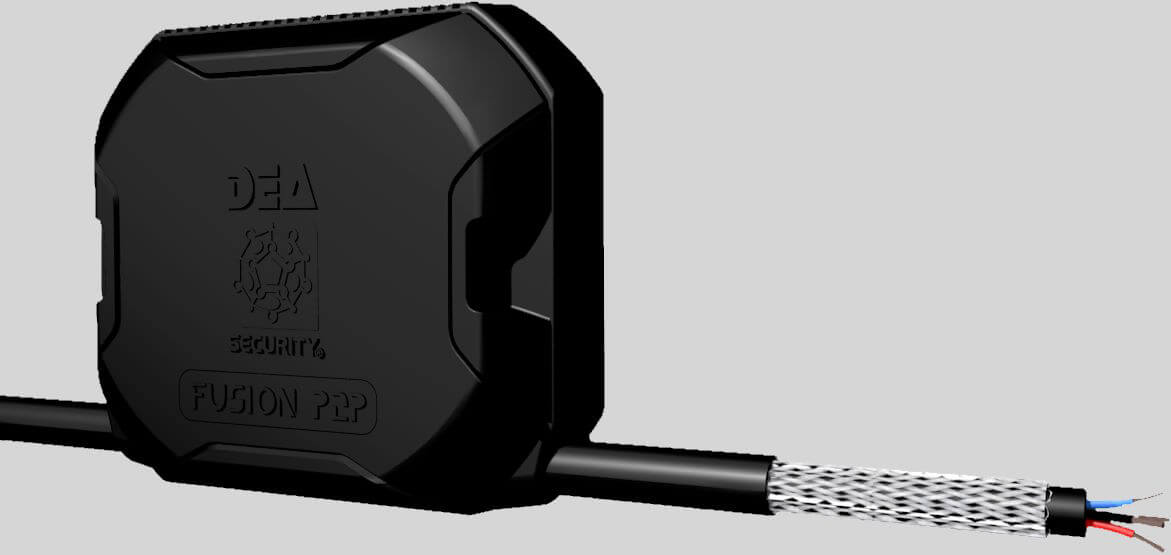FUSION P2P
FENCE-MOUNTED DUAL-TECH INTRUSION DETECTION SYSTEM
Controller Lite
Ideal for smaller perimeters
Armoured cable
Protected by metal braid
WHAT IS IT ABOUT?
FUSION P2P is the new generation of DEA fence-mounted intrusion detection systems. It is the first outdoor perimeter system to employ DEA Sensor Fusion (DSF) dual-tech detection technology, thanks to which it redefines the current industry standard as far as performance and versatility are concerned.
WHERE IS IT EMPLOYED?
The system can be mounted on soft, semirigid and rigid fences, and on the most common types of walls.
HOW DOES IT WORK?
FUSION P2P senses and analyses the vibrations and the movements of a fence while an intrusion attempt for cutting (also performed by means of hacksaws or angle grinders), breaking through or climbing is occurring, discriminating all of those noises which could trigger improper alarms.
The detectors employ two different sensitive elements: a well-proven PIEZOELECTRIC transducer and a MEMS accelerometer. The data coming from the two sources of signal are processed and analysed using adaptive intelligence algorithms able to recognize the intrusion attempts and discriminate them from the environmental and climatic noises.

FUSION P2P system is designed in accordance with Security Grade 4 (high risk) of Directive EN 50131-1.
WHAT DOES IT CONSIST OF?
The system is composed of prewired sensor-strings, preassembled electronic control units, junctions and terminations. The sensor-strings are available with two different spans between the sensors: 5 metres (strings with 5 or 15 sensors) and 3 metres (strings with 5, 15 or 25 sensors).
The control unit manages up to 300 detectors on two communication buses for maximum 1.500 metres of perimeter if the span between the sensors is 5 metres and 900 metres of perimeter if the span is 3 metres. Besides enabling the configuration of the detectors by means of a service software, the control unit automatically recognizes and sorts the field detectors and raises the alarm signals.
For smaller compounds is now available the controller Lite (BR-FSP2PLT-CTRL) which manages up to 100 sensors on a single communication bus. This board has the main features and functionalities of the standard controller (the one assembled inside the control unit).
Junctions (beginning of string and intermediate) and terminations are connectorized, therefore they do not need any sealing or welding on site. The connection cable is now also available in armoured version, namely protected by a heavy-duty anti-rodent galvanized iron braid armour.
THE MOST IMPORTANT ADVANTAGE
FUSION P2P offers several advantages, among which the most important are the detection reliability and the versatility. As far as the versatility is concerned, the system can protect almost any type of metal fencing, from soft to rigid structures and thanks to the possibility of calibrating the detectors individually, the same sensor-string can be applied to heterogeneous structures without dividing it in more sensor-strings.
DEA Sensor Fusion technology
DEA Sensor Fusion (DSF) is a signal processing technology employed in DEA’s latest generation intrusion detection systems. Its peculiarity is that it combines, in a single detector, two different types of sensitive elements: a PIEZO transducer and a MEMS accelerometer.
The data acquired from the two sources of signal are analysed using adaptive intelligence algorithms: these algorithms integrate this information, interprete it and make real time decisions based on the knowledge implemented in the firmware and based on the environment perception.
The adjective which best describes the DSF technology is “holistic”, namely the functional sum of the two transducers, PIEZO and MEMS, is higher than the sum of their performance taken individually. In other words, DSF goes beyond the limits of these single technologies and, combining their key benefits, reaches an unmatched level of reliability.
Thanks to DSF, the new generation of DEA detectors are able to adapt to a greater variety of structures, materials and operating conditions, always keeping the highest performance. And all this without complex and boring calibration activities: in most cases it will be sufficient, during the first configuration of the system, to select the type of structure to be protected.
Key benefits
DEA Sensor Fusion technology
The new DSF technology developed by DEA Security combines, in a single seismic sensor, all of the benefits of a traditional Piezoelectric transducer with the advantages of a MEMS accelerometer. The outcome is a detector capable of the highest performance.
Adaptive intelligence
Thanks to the complex adaptive intelligence algorithms, the system can work best on almost any metal fence and walls and in environmental conditions which could strain any other traditional detection system.
Maximum environmental immunity
The immunity to environmetal and climatic nuisances featuring SERIR systems is here at its utmost. As a matter of fact, thanks to its noise limiter function, FUSION P2P is able to recognize and digitally filter the disturbances generated by adverse climatic conditions.
Redundancy support
FUSION P2P can be installed in ring topology, which allows the sytem to continue functioning efficientely following a bus cable cut performed anywhere along the sensor-string.
Structure type presets
In most cases it is possible to calibrate the system with a simple mouse click. As a matter of fact, the system provides seven different default configurations suitable for several types of structures.
Self-test on each sensor
FUSION P2P sensors have a self-test function which readily signal potential functioning failures. This makes periodical on-site check unnecessary and service operations quicker.
IP native support
The controller board is equipped with an Ethernet interface which allows the system to connect to a TCP/IP network and to exchange data with third-party systems and equipment. Thanks to specific plug-in software, the system can also integrate the main PSIM and VMS software.
Professional easy-plug connectors
The prewired sensor-strings employ, on both of their ends, professional easy-plug connectors with IP68 rating and military-grade specifications. These connectors make the electrical connection of the strings very fast and error-proof.
Anti-tamper and anti-removal
The sensors are equipped with devices which detect the removal and the thermal and magnetic tamper attempts.
Smart automatic sorting
During the first activation of the system, the controller automatically performs the identification and sorting of the sensors.
General and individual calibrations
Each sensor can be calibrated and configured together with the others of the same logical line or individually.
Factory wired sensors
FUSION P2P sensors are factory wired, sealed and tested in order to reduce to zero potential wiring mistakes on site.
Controller Lite
The new controller Lite makes FUSION P2P even more suitable for being employed in smaller compounds, such as residential sites. Unlike the standard controller, which manages up to 300 sensors on two communication buses, the controller Lite supports up to 100 sensors on a single bus. The other key features, such us the sophisticated signal analysis and the IP network native support, remain unchanged.

Armoured cable
FUSION P2P is now also available equipped with armoured cable, namely protected by a robust antirodent galvanized iron braid armour. This feature, which both the sensor-strings and the connection cable installed in underground or exposed ducts can benefit from, adds an effective protection from rodents and maximizes the durability of the cable.
Service software
FUSION P2P is equipped with a user-friendly software which allows you to check the operating parameters of the system and the input and output status. The software also provides the configuration and calibration tools of the sensors, easily reached from a single screen. From here you can:
- select the type of structure to be protected;
- set the security level;
- calibrate the sensitivity level;
- configure the sporadic cut detection;
- calibrate the sensor spatial positioning;
- configure the self-test function;
- save or upload a configuration file;
- download, view, delete or send the logs via e-mail.
